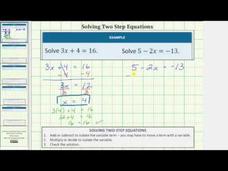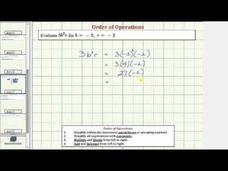Virtual Nerd
How Was the Distance Formula Derived?
Are you working on the distance formula? Derive the distance formula and help your learners by showing them the logic behind the distance formula. This practical video should help conceptual understanding and is appropriate for in-class...
Northeast Arkansas Education Cooperative
Multiplying Binomials Using the Distributive Property
Where many multiplying binomial lessons introduce the tool of FOIL and move on, this video presentation really delves into the how's and why's of the distributive property. Careful treatment of distribution and explicitly written out...
Curated OER
How Do You Find a Value to Make an Open Sentence True?
What is an open sentence? Don't know? Want to find out? Watch this lesson on what makes an open sentence in math and learn how to solve and answer the problem.
Mathispower4u
Solving Two-Step Equations (Basic)
Solving equations is as easy as 1-2-3. Using two examples, the video shows the order of the steps to use when solving a two-step equation. It uses a vertical approach to perform the inverse operations to isolate the variable. To finish,...
Welch Labs
Imaginary Numbers Are Real (Part 3: Cardan's Problem)
Were complex numbers discovered or invented? A video presentation makes the case for the discovery of square roots of negative one. In order for complex numbers to be real, then they must behave like other numbers, which they do in terms...
Mathed Up!
Using a Calculator
Here's a video that presents several numerical expressions to be evaluated using a calculator.Viewers come to realize that sometimes it is not just a matter of punching in the numbers, but they also need to be concerned about how the...
Mathispower4u
Evaluating Algebraic Expression (L1.3)
You'll definitely find value in a helpful video. Young mathematicians watch a YouTube video to learn about evaluating algebraic expressions for given values. The video goes through several examples, including both mathematical and...
Mathispower4u
Evaluate an Expression in the Form 3x^2y (Example)
What's the value in learning about 3(b^2)r? A brief YouTube video demonstrates how to evaluate the algebraic expression 3(b^2)r. Specifically, scholars find the value of this expression when b = -3 and r = -2.
Curated OER
How Do You Solve a Word Problem Using an Inequality With Variables on Both Sides?
Don't skip this word problem! Take one piece at a time in writing out this inequality. Once you have an expression that represents the words in this inequality, the rest will seem easy. So watch this video to get a better understanding...
Curated OER
How Do You Use Division With Positive Numbers to Solve an Inequality Word Problem?
A word problem with one variable and two given numbers. This word problem seems doable from the start. Wait, it's an inequality. Don't worry about that piece, just get the expression written and do the math. Watch this video and see how...
Curated OER
How Do You Solve a Quadratic Equation by Using the Quadratic Formula?
Use an informative video on the quadratic equation to help math learners of all levels. Remember that if there is a solution, there will be two values. In word problems, it might be that only one of the values might answer the question....
Northeast Arkansas Education Cooperative
Multiplying Polynomials
Without ever relying on the FOIL trick, this presentation carefully walks young algebrists through multiplying binomials by a monomial and by each other. Examples start easy, but move into complicated pairings of coefficients, positives...
Krista King Math
Multiplying Multivariable Polynomials
Combine operations when working with polynomials. The video examples incorporate both multiplication and subtraction of polynomials. The polynomials also have multiple variables to add to the complexity.
Curated OER
How Do You Compare Two Whole Numbers?
Two very similar numbers and you have to figure out which one is larger. The teacher diagrams a place value chart and shows you how to write the two numbers to make a comparison.
Curated OER
How Do You Solve a Word Problem Using the Elimination by Subtraction Method?
Use word problems to teach systems of equations! The instructor in this video demonstrates how to solve a word problem using a system of equations and the elimination by subtraction method. She goes through each step, carefully...
Mathispower4u
Evaluating Algebraic Expressions
What types of mistakes do your classes make when evaluating algebraic expressions? A direct video lesson explains the process of evaluating algebraic expressions by substituting values for multiple variables. The instructor highlights...
Mathispower4u
Simplify and Evaluate Algebraic Expressions 1
Evaluate the equivalence of expressions. A helpful video walks through the process of simplifying two expressions. Using values for the variables, the presentation evaluates the original expression and the simplified expression to show...
Mathispower4u
Evaluate an Expression in the Form (a-b)/(cd) (Example)
There's no substitute for learning through examples. A brief YouTube video shows how to evaluate an algebraic expression through substitution. The expression of interest is in the form (a-b)/(cd), where the values of the variables are...
Curated OER
How Do You Solve an Inequality by Multiplying by a Positive Number?
Instruct your pupils on solving inequalities by multiplying by positive numbers with this video. The video presents how to do just this in step-by-step fashion. A straightforward video, this could be used to supplement your lesson during...
Curated OER
How Do You Solve an Inequality by Multiplying by a Positive Number?
Instruct your pupils on solving inequalities by multiplying by positive numbers with this video. The video presents how to do just this in step-by-step fashion. A straightforward video, this could be used to supplement your lesson during...
Mathispower4u
Simplify Polynomial Expressions - Add/Subtract/Multiply (Example)
How are your classes with polynomial operations? If they need a little extra support, this is the video for you! The lesson instructor explains several examples building from a simple addition of polynomials to a more complex example...
Corbett Maths
Inverse Functions
The opposite operations in the opposite order create the inverse of a function. A video demonstration explains the algebraic steps in creating inverse functions from different types of functions. The examples include linear, rational,...
Curated OER
What is Domain?
The teacher illustrates several ways to look at what the domain is in a set of numbers. Input, output, table, graphs, and diagrams are a few of the ways in which she illustrates the meaning of domain.
Curated OER
What is the Domain of a Relation?
The teacher illustrates several ways to look at what the domain is in a set of numbers. Input, output, table, graphs, and diagrams are a few of the ways in which she illustrates the meaning of domain.
Other popular searches
- Math Order of Operations
- Math: Order of Operations
- Mathematics Order of Operation
- Order of Math Operation

























